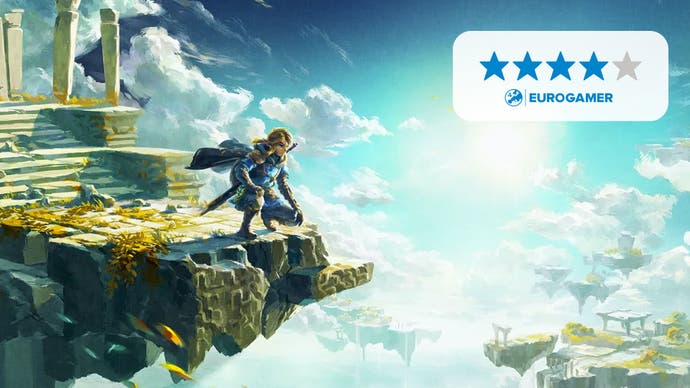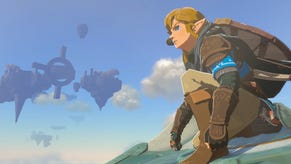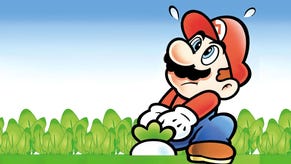The Legend of Zelda: Tears of the Kingdom review - Hyrule reborn bigger and busier
Wind walker.
You've probably seen and read a lot about Zelda: Tears of the Kingdom's heights, so let's start by plumbing its depths. The most accessible of these are water wells - around 50 in total, typically located near villages and stables, though a few lurk in the bellies of forgotten ruins. Drop in, and sometimes, all you'll find below are puddles and moss, a few lizards you can toss into a potion, and the trace of a story. One well I visited had a hydroponics garden beneath it, with melons swelling in the glare of bioluminescent shrubs. Another harboured a fellow well-enthusiast, one of the many charmingly written vagrant nerds you'll meet in Tears of the Kingdom's vertically expanded Hyrule, who promptly handed me a sidequest to discover - you guessed it - all the other wells.
Wells are fleeting distractions, a nice way to cool off after a giddy descent from a floating island, or warm yourself up for the next major dungeon after a night at the inn. But sometimes, you spy a cracked wall you can shatter with a rock hammer you've improvised by fusing a boulder to a rusty sword. You stroll through the gap expecting a treasure chest or similar, and find yourself in a labyrinth. There could be anything down here - a skeleton ogre encased in brittle magma; a dusty palanquin housing a piece of antique armour; a multiple-storey cavern full of flammable brambles, screaming wall-crawlers, and outcrops of precious ore.
Occasionally, you come away from these cave systems dissatisfied, with nothing but a pocketful of mushrooms in return for 10 minutes of sweaty excavation - a process not helped by the returning weapon degradation system, which obliges you to fashion new mining tools at regular intervals. As with Skyrim's old Draugr dungeons, there's a slight sense of design-by-spreadsheet, and a greater commitment to filling in spaces the previous Zelda game, 2017's Breath of the Wild, left powerfully vacant. But many of these underground warrens are marvellous in scale and intricacy, and I haven't even gotten to the best of them - the Chasms, huge, billowing rips in Hyrule's geography, which provide access to a full-blown second open world lurking beneath the first.
If the wells and smaller cave systems recall Skyrim's barrows, the Chasms feel like nods to that game's sprawling Blackreach undercity - and also, the Nether in Minecraft. It's a realm of sweeping Hadean planes, sporing fungus, lava flows and eerie, gesturing statues. The first thing you have to worry about here is illuminating your surroundings, whether by eating something that makes Link glow, or kindling one of the vast Lightroots that are the Chasm equivalent of the surface world's map-revealing towers. The second thing you have to worry about is Gloom, a flickering crimson substance that lowers your maximum health on contact: initially, you'll need to return to the surface to repair the damage. The enemies in Chasms are infested by the stuff, which makes raiding their camps a dicey prospect indeed. There's no damage-cancelling your way out of trouble by gobbling down six mushroom skewers in one go.
You could spend an entire game in the Chasms, ferreting about for buried riches and side dungeons, experimenting with the properties of lava, which isn't just a hazard, and fighting colosseum battles for nifty helmets. But Tears of the Kingdom is fiendishly designed so that many of the items you need to survive underground can only be found high, high above. Likewise, the Chasms contain items that can only be traded or processed elsewhere. So after an hour of spelunking, you fast-travel to one of the Skyview Tower mancannons that now dominate Hyrule's surface regions, and launch yourself back to the heavens.
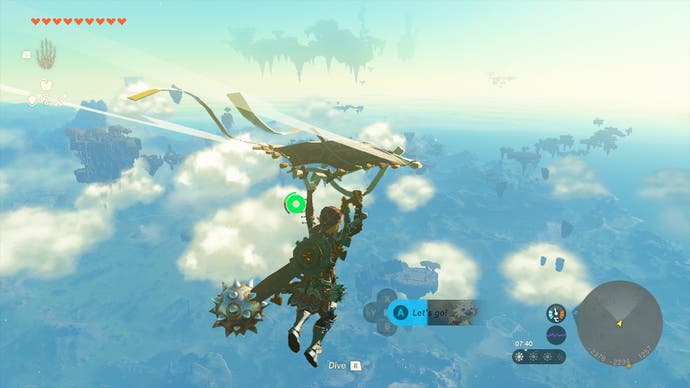
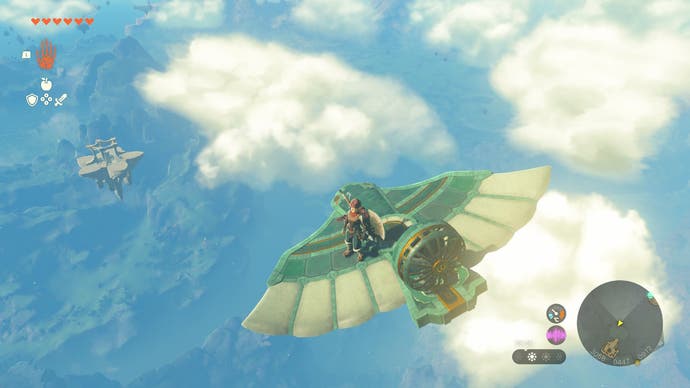

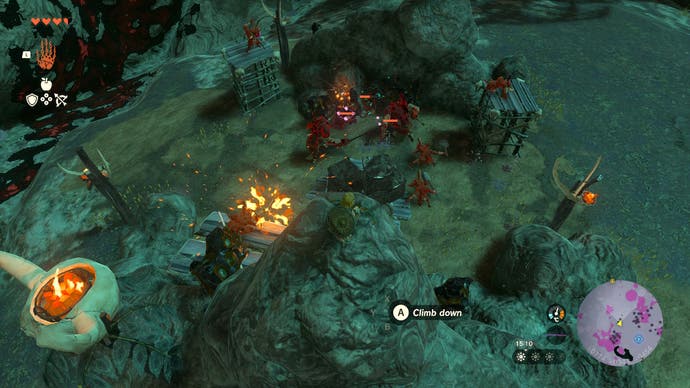
This loop between underworld and sky is the heart of Tears of the Kingdom, the dynamo that propels both its narrative and its rhythms of exploration and resourcing. The game establishes it in the very first story scene. As the curtain rises, Princess Zelda and a fully-upgraded, Master Sword-toting Link are exploring the darkness beneath Hyrule Castle. They discover curious murals about Hyrule's past, together with an emaciated demon corpse, which - as is the way with emaciated demon corpses - immediately reanimates and kicks off the apocalypse, spreading calamity across the world map and lifting Hyrule Castle itself on a pillar of Gloom.
Link awakens days later in a musty, overgrown crypt to find Zelda vanished, his progression reset, and his left arm mysteriously transformed. It's Breath of the Wild's Shrine of Resurrection, again, but the view from the end of that opening tutorial tunnel is another thing entirely. Stepping into the light, you find yourself on a gorgeous archipelago of silverbirch forests and mountains, crystal-clear rivers and boxy magical relics suspended hundreds of metres above the clouds.
The sky islands are as majestic and exhilarating as the Chasms are oppressive and intriguing. They come in all shapes and sizes, each fashioned from shockingly bright, spiral-combed rock, dreamy yellow foliage and the blue-green electric tones of the ancient Zonai civilisation that once resided here. Some are floating ruined villages composed of multiple levels, defended by wobbly stone robots. Others are home to shrines - Breath of the Wild's Tardis-like puzzle dungeons, which bequeath orbs you can exchange for higher max health and stamina. A few are glorified minigames - sky-diving courses, or open-air conundrums involving lasers - while others are pleasing chunks of worldbuilding, such as massive refineries linked by mining railways.
Where Tears of the Kingdom's caverns aren't always worth the toil of discovery, none of the sky islands feel dispensable. All have an irresistible, toylike specificity that recalls Wind Waker as much as the obvious comparison, Skyward Sword. A few are just metre-wide fragments topped by a single tree, places to recover stamina while island-hopping with your glider. But even here, there may be apples to gather and birds to overhear. The islands also, of course, lend a new aspect to the realm beneath, which is now tattooed with enormous geoglyphs that hide pools of enchanted water. These offer clues to the fate of Zelda, who is still fundamentally a damsel in need of rescuing, but a more enigmatic figure here than in Breath of the Wild.
My favourite island is the very first you set foot on, the Great Sky Island, to which you'll frequently return over the ensuing hundred or more hours of play. As with Breath of the Wild's Great Plateau, it's both an elegant, condensed version of the game as a whole and a cosy learning environment, with shrines and traversal puzzles that slowly introduce you to the key workings. There's much more to learn this time. Link retains his all-important ability to clamber up any surface, and you eventually reclaim your paraglider, thank goodness. But your old Sheikah Tablet powers are kaput. In their place, you're handed four new abilities that both expand on and tug against habits picked up in the previous game.
Ascend is the simplest - it's deceptively simple, in fact. It lets you magically tunnel up through any flat surface directly above you, as long as it's not too high and there's a navigable area on the other side. It helps you get around sky islands, but also speeds your traversal of the mountainous regions beneath, much as Link's old Zora armour allows you to salmon-rush up waterfalls. Over time, it subtly alters how you think about Hyrule's sweeping views: rather than just looking for high points to glide from, you're keeping an eye out for overhangs you can Ascend through.
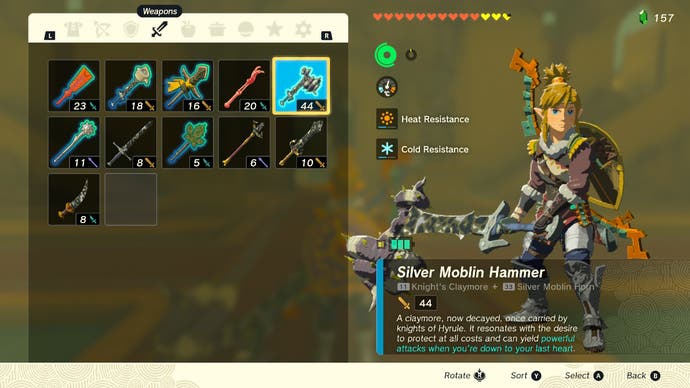
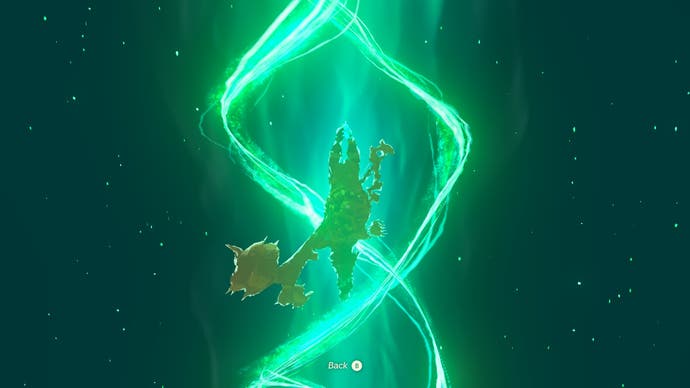
Rewind, meanwhile, turns back time for the object you aim it at. It has some elementary applications in battle - if a Moblin lugs something explosive at you, hit the rewind button to send it curtly back where it came from. But it also allows you to travel between ground level and the sky islands in a wonderful, obvious-in-hindsight way I'd rather not spoil. And it plays a central role in many of the puzzles that hew closest to the lock-and-key style of Zelda games from before Breath of the Wild.
The least convincing of Tears of the Kingdom's new abilities is Fuse, though it grows on you with practice. This lets you glue weapons, shields and arrows to pretty much any other object, from a minecart to a fire-emitting ruby, increasing their attack power and sometimes producing a novel piece of equipment, such as a spear with a tentacle whip or an arrow that defies gravity. It feels like a response to complaints about the first game's weapon degradation. Weapons still shatter after a few swings, but rather than simply replacing them, you're crafting your own exotic varieties, which makes adding to Link's arsenal more of a playful act than sheer maintenance.
The trouble is that a lot of Fuse combinations are duds - stick a mushroom to a shield and hey presto, you've got a mushroom stuck to a shield. It's quietly funny the first time it happens, less so on the 10th attempt. Other combinations are useful but unexciting, such as swords that deal +17 damage or have a longer reach. But as with the returning cooking system - which now benefits from handy recipe cards that automatically fill Link's hands with the ingredients for each dish you've discovered - the disappointment of this fades as you learn more and more combinations and slowly get to grips with the underlying logic.
Still, it's nowhere near as entertaining as Ultrahand, which lets you seize and glue together objects to make vehicles, buildings and, well, whatever daft idea comes into your head, using a fiddly but manageable editing UI. While the other abilities add their own peculiar spice to Breath of the Wild's returning survival and traversal systems, it feels like the entire world of Tears of the Kingdom is built around Ultrahand. It's one sprawling exercise in gathering raw materials together with the knowledge of how to combine them.
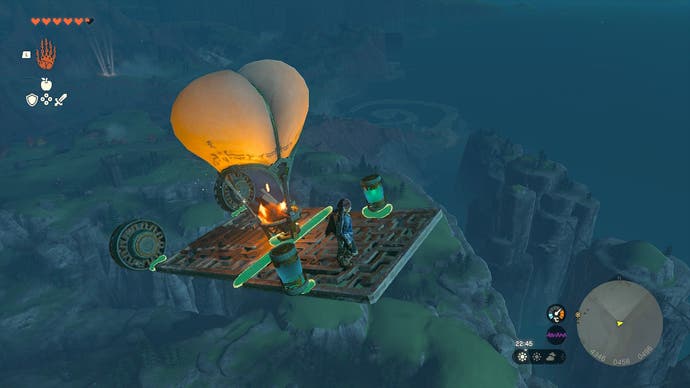
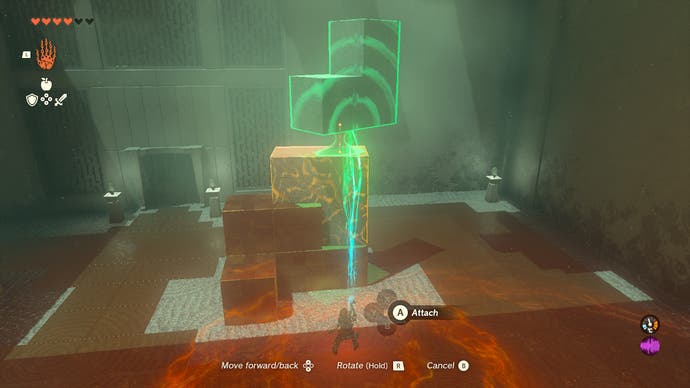
The key components are Zonai mechanisms, which are mostly obtained by feeding pieces of destroyed Zonai robots into huge, bubble-topped Gacha dispensers - a slightly bizarre allusion to gaming's fraught association with gambling. These range from single-use rockets and lava-proof monster tyres to sleds, trolleys and stakes that can be plunged into surfaces to create attachment points. The machine components are toggled on and off with a blow, and powered using an upgradeable recharging portable battery. Initially, the battery only has enough juice for 20-30 seconds of operation, depending on the complexity of your creation, but you can spend Zonai charges to top it up, much like drinking stamina potions while gliding, or bolt on external batteries that evaporate once drained.
While Ultrahand is more about bolting together prefabs than a full-blown construction sim such as Minecraft, it allows for a beautiful variety of desperately unsafe contraptions - many taught or suggested to you by shrine puzzles, which sometimes take the form of simple combat or archery challenges, but are more often tacit Ultrahand laboratories. Needless to say, some of the most enjoyable things to cobble together are planes. There's a touch of the history of aviation to how you progress from angling a simple glider with your own bodyweight to fielding credible jetfighters with steering columns, landing wheels and beam cannons.
After descending to Hyrule, you can also harness your horse to anything you build with Ultrahand, mounting flamethrowers to a wagon so as to blast through Bokoblin formations without drawing your sword. It even alters your approach to bossfights, albeit with very mixed success in my case. Rather than just firing bomb arrows at that lava crab's eyeball, why not have your fan-propelled, halberd-armed clapboard battle mech do the dirty work for you?
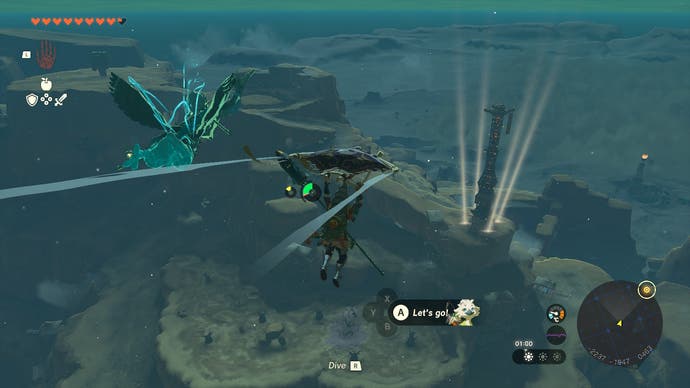

The landscape between the sky islands and the depths is, of course, where Tears of the Kingdom feels closest to Breath of the Wild. There are many new flavours of optional activity, but many of the fixtures are familiar: enemy outposts with a trick to them, such as boulders positioned on the cliff above; towers you must activate to reveal the world map, a process that now involves punting yourself skywards to snap photographs; towns full of bitty but diverting sidequests, and the constant suspicion that every stray boulder or anomalous plant has a Korok lurking beneath it. The game also follows the same broad narrative of visiting the homelands of Zelda's four non-Hyrulian factions, helping them out with some local difficulty that always involves a dungeon and one or two bossfights, before finally making a run on Hyrule Castle itself.
The major dungeons are elaborate and enjoyable, though perhaps more of a step sideways than forward from those of Breath of the Wild. First, there's the process of getting to them - tracking down a key face and navigating some intervening scenario, which has its own distinct theme and mechanics. The Zora quest, for example, has you flapping around in floating water bubbles, while the Gerudo quest involves a touch of base defence, positioning the troops and setting up lightning traps for desert ghouls. The dungeons themselves look and feel very different, but they all consist of activating a series of fiendishly obstructed mechanisms using a companion's abilities, before taking down a boss.
There's still plenty of good old-fashioned empty space... but this is the first Zelda game I've played which feels designed to be farmed.
The repetition of the formula means that the first dungeon you visit will likely be your favourite, but all of them are satisfying to unpick - or if you prefer, to cheese by using your various powers and traversal skills in underhand ways. Aside from advancing the main plot, your reward for completing each major dungeon is a summonable phantom companion who fights alongside you. Each phantom has a special move, such as a gust of wind that extends your glides. You can choose to travel without companions - they have the usual video game sidekick habit of photobombing your landscape shots, and their combat barks are an irritating counterpoint to the game's elegantly sparse orchestral score. But their showpiece moves can be extremely handy. The Goron ability, for example, allows you to quickly clear out clumps of boulders while harvesting resources underground.
There are a lot of resources to harvest. While its fancy new abilities and alternately stratospheric or Stygian spaces might steal the limelight, what I remember most about Tears of the Kingdom, after a couple of weeks' play, is the focus on collecting. There are more things to upgrade, from your Zonai battery, which requires you to gather ore in Chasms and caves for processing and trading on the sky islands, to the addition of (at least) two new Mother Goddess-style effigies you can swap stuff with. Ultrahand and to a lesser extent, Fuse both spur your imagination and cultivate an insatiable hunger for new pieces to experiment with.
It's never an exercise in brainless pillaging, but the sheer acquisitiveness of it all might annoy you if you enjoyed Breath of the Wild for its relative austerity. There's still plenty of good old-fashioned empty space to explore - I spent 15 minutes scuttling over one particular sunken temple roof, only to find nothing at the far end but a hot air balloon I could use to escape the canyon. But this is the first Zelda game I've played which feels designed to be farmed.
I've compared Tears of the Kingdom to Skyrim and Minecraft, but the game it makes me think of most is Assassin's Creed. The original Assassin's Creed tower loop is one of the most famous and formative in gaming: you clamber out of the world and its distractions, only to dive back in, a process that serves to unlock nearby missions and opportunities, as though your avatar were the plunger on an oil derrick, pumping the game's content out of the earth. In borrowing Assassin's Creed's towers, while trimming back or at least, hiding the busywork, Breath of the Wild reasserted that simple up-and-down process long after Assassin's Creed's sequels had buried it in optional content.
Tears of the Kingdom is sort of one enormous, invisible Assassin's Creed tower, constructed not just of stone and metal but of play rhythms stemming from the distribution of objectives and raw materials. It's an ephemeral and imposing structure that extends all the way from hell to heaven. Both its main quests and its various resourcing elements guide you steadily up and down this airy edifice: your eyes are constantly being drawn from one half of the game to the other.
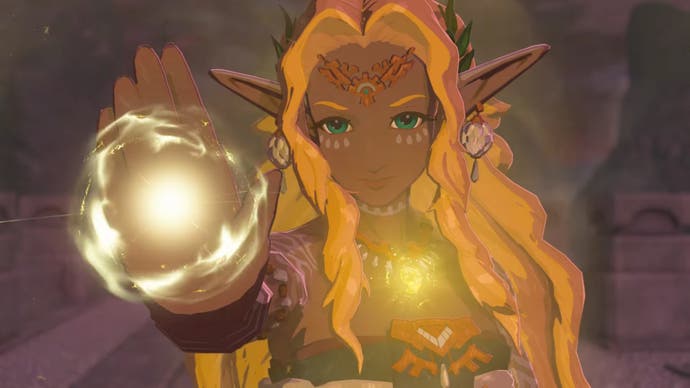
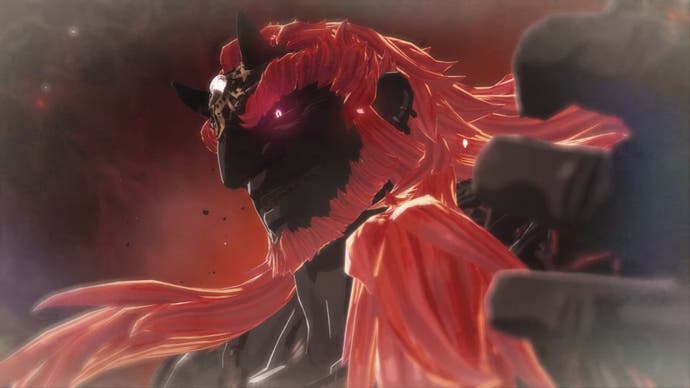
It's never insistent about this. There's always that freedom to linger, to construct something silly, chase a fox through the woods, or land upon a lonely sky islet for the joy of it. The pull exerted by all those things to collect and upgrade is gentle, by open world standards. At the same time, I do wonder where Zelda goes after this, and whether its destiny is to forget the key lessons of Breath of the Wild and follow Assassin's Creed into the realm of "stuff for the sake of stuff". I'm hypnotised by the view from every aerial landmark I visit, and compelled by the seething darkness underground. But every so often, after completing a samier shrine or dungeon, I think about Fuse and the number of either unusable or worse, incrementally enhanced weapons it produces, and I wonder whether it's the canary in the coalmine here.
Tears of the Kingdom is a direct sequel, for all its changes, and Zelda tends not to go in for those: it used to wipe the slate clean each time, casting the last game's baggage aside like so much surplus equipment, and setting out for the horizon. I'd like the next Zelda to do that again. But that's a problem for tomorrow. All told, Tears of the Kingdom is an astonishing, quite literally top-to-bottom sequel, adding complexity and splendor to the Breath of the Wild formula without sacrificing its enchantment.
